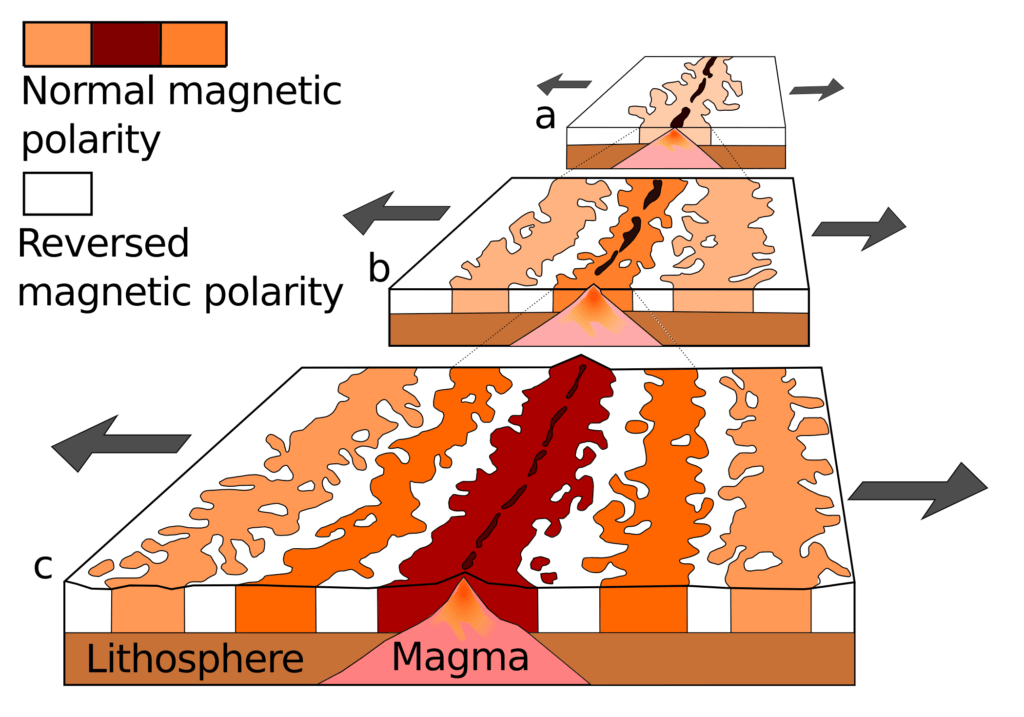The Earth’s North magnetic pole has long been an essential tool for navigation. Compass needles with one side magnetized always point towards this magnetic pole, and early people thought a magnetic island existed somewhere in the great cold North. William Gilbert (1600, De Magnete) proposed that the Earth acted as one giant magnet, with magnetic poles in which the needles were attracted. He also determined that the magnetic pole is where magnetized needles would point down toward the ground.
In modern times, the pole is well understood. However, the geographic North pole is not in the same place as the North magnetic pole—which is actually the South magnetic Pole because the north poles of magnets are attracted to it. Furthermore, the magnetic pole wonders, approaching speeds of over 50 km per year over the past decade.
Even weirder, the poles can flip, called a pole reversal. Today, the poles are in a standard configuration, whereas the magnetized North is in the Northern hemisphere. However, the pole will sometimes flip, and the magnetized North will be in the Southern hemisphere. These geomagnetic-reversal events are recorded in the rock record, where locked magnetic indicators will lock in the alignment of the current pole configuration. The last period where the poles were abnormal was 900,000 to 780,000 years ago, named the Brunhes–Matuyama reversal.
What is a Superchron?
A superchron is an abnormally long period of pole configuration, lasting 10 million years or longer. The Cretaceous period recorded one of the most prolonged events, lasting about 37 million years. At times the poles can switch often; 42 million years ago, some 17 reversals took place over 3 million years.
There is great difficulty in keeping a record of pole reversals in older rocks. The surface rocks on Earth recycle often, and records of pole reversals can be subducted under continents during normal plate movements. The mid-Atlantic ridge is a seafloor-spreading center where new land is deposited and continues to widen the Atlantic. In numerous core samples taken over the past 70 years, researchers can see a striped pattern of ordinary and reversed magnetic signatures in the cooled magma rocks on the seafloor.
This has provided great accuracy for pole configuration over the past. The oldest rocks on the Atlantic seafloor are 180 million years of age. Some rocks have iron components that record the alignment as they form but require conditions that prevent chemical alteration of the environment before they are collected and measured. The older the bedrock, the more likely it will have been altered from its initial state.
Now, the Permo-Carboniferous Reverse Polarity Superchron
From 318 to 262 million years ago, the Permo-Carboniferous Reverse Polarity Superchron was a long period of the reverse magnetic polarity of the Earth’s magnetic field. This lasted over 50 million years and appears to be the longest known today.
I am curious about this particular Superchron because it occurred when the rocks were laid in Armstrong County, PA. Having a reverse field is interesting, but the fact that it was one of the longest-known is even more enjoyable. Did this affect life? The debate continues; a pole reversal’s effect on the biosphere is unknown, and many theories exist.
When a pole reversal occurs, it is thought that magnetic North and south can crop up anywhere in a chaotic way. The strength of Earth’s magnetic field can temporarily lower and allow more radiation from space to enter the atmosphere. If anything, life during a superchron may have less radiation and other disrupting factors.
References
- De Magnete, Peter Short, London, 1600
- R.D. Cottrell et al., 2008, Physics of the Earth and Planetary Interiors 169, pp. 49–58


